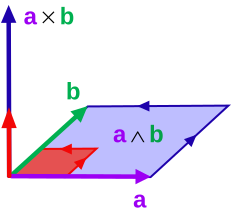Canonically, the [wedge product](http://mathworld.wolfram.com/WedgeProduct.html) is distinct from the [cross product](http://mathworld.wolfram.com/CrossProduct.html) and should not be confused, however in three dimensions they are inextricably linked.
The wedge product (or outer product) comes from [exterior algebra](http://en.wikipedia.org/wiki/Exterior_algebra), first due to [Grassmann](http://en.wikipedia.org/wiki/Hermann_Grassmann) who generalized vector products to arbitrary dimensions. This would later be extended by [Clifford](http://en.wikipedia.org/wiki/William_Kingdon_Clifford) into the [Clifford Algebra](http://en.wikipedia.org/wiki/William_Kingdon_Clifford), which would unite the inner and outer products for arbitrary dimensions.
The cross product itself would come from a term in the [quaterion](http://en.wikipedia.org/wiki/Quaternion)'s first described by [Hamilton](http://en.wikipedia.org/wiki/William_Rowan_Hamilton). It only exists in three dimensions, and is defined as
$$ \vec c = \vec a \times \vec b $$
$$ c_i = \epsilon_{ijk} a_j b_k $$
Where $\epsilon$ is the [Levi-Cevita symbol](http://en.wikipedia.org/wiki/Levi-Civita_symbol), a completely anti-symmetric "tensor"
$$ \epsilon_{ijk} = \begin{cases} 1 & \text{$ijk$ an even permutation of 123} \\ -1 & \text{$ijk$ an odd permutation of 123} \\ 0 & \text{otherwise} \end{cases} $$
This defines a vector that is perpendicular to the other two vectors. And there we can immediately see the problem. In dimensions higher than 3 there is no longer a unique direction perpendicular to two vectors, there is an entire subspace.
To get around this difficulty, Grassmann had to change the geometric interpretation of the vector product. His wedge product (or outer product) takes two vectors and returns an object that represents the oriented, scaled plane that the two vectors span, and axiomatically is defined to be antisymmetric.
$$ \vec a \wedge \vec b = - \vec b \wedge \vec a $$

<i><sup>From [wikimedia](http://en.wikipedia.org/wiki/Exterior_algebra#mediaviewer/File:Exterior_calc_cross_product.svg)</sup></i>
This can naturally be extended to further geometric objects by wedging by still further vectors to build up a fully complete algebra.
Now we can write the correspondence between the cross product and the wedge product:
$$ \vec a \times \vec b = \star ( \vec a \wedge \vec b) $$
This is pretty unsatisfactory as an equation, for I've hidden all of the relevant bits into a new symbol: ($\star$), which represents the [Hodge dual](http://en.wikipedia.org/wiki/Hodge_dual). You see, one of the consequences of this geometric algebra of Clifford is that you can only wedge things against each other so far, eventually you run out of *space* to wedge against. Additionally, the dimensionality of any particular rank of objects in this algebra happen to correspond to rows of Pascal's triangle. In particular, in three dimensions we have:
$$ 1 \quad 3 \quad 3 \quad 1 $$
Which is to say, we have 1 linearly independent scalar, 3 independent vectors, 3 independent planes and only 1 independent volume element. For four dimensions you would have
$$ 1 \quad 4 \quad 6 \quad 4 \quad 1 $$
1 scalar, 4 vectors, 6 plane elements, 4 independent (3D) volumes and only 1 4D volume. It is always true that these sequences are symmetric about the middle. This allows us to define an operator: ($\star$) the hodge dual, that maps from an object on the left half of one of these sequences to the right half and vice versa. In particular, this allows us to associate any plane in 3D with a corresponding vector. This is entirely natural, we do this all of the time in 3D, the natural vector associated with a plane is just the vector perpendicular to the plane. In 4D, every vector is associated with a 3D volume element and vice versa.
At this point, we notice that 3 dimensions is quite special. The natural vector product ($\wedge$) takes two vectors and creates a plane element, but in 3D we can always uniquely assign a vector to this (orientated) plane, this associated vector is the cross product. The wedge of two vectors in any higher dimension cannot be uniquely associated with a vector, as I have hopefully made clear.
It all seems nice a tidy, but the fact that the vector generated by the cross product isn't the *natural* result of vector multiplication leaves a sort of smudge on the vectors created by cross products: they transform differently under reflections. This creates the whole confusion over [pseudovectors](http://en.wikipedia.org/wiki/Pseudovector). The product of vectors is *naturally* a plane, and planes don't switch sign under reflection, while vectors do. For more details see this [answer by ACuriousMind](https://physics.stackexchange.com/a/130105/51994) to another question.